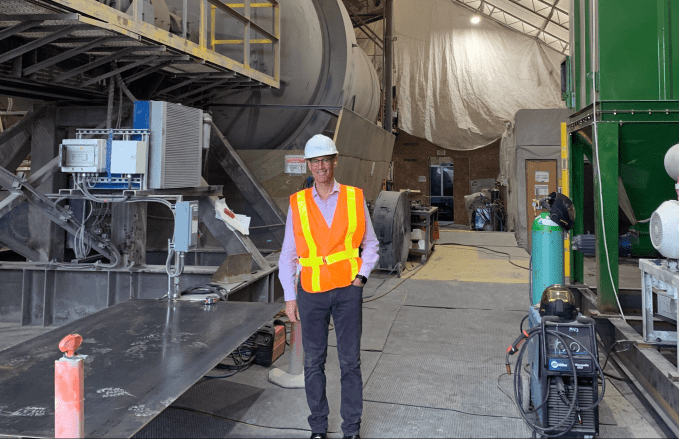In the climate tech world, Dan Goldman has seen just about everything: From the clean tech boom that led to the clean tech bust, the dark years that followed, and today’s bull market that’s transformed climate tech into one of the hottest sectors in the venture world.
TechCrunch caught up with Goldman this week to hear what he thinks about today’s market and what he’s telling his portfolio companies about how to prepare for next year.
“We do want them to be extremely cautious about cash all the time, but especially now,” he said. Though the reasons why that’s the case today aren’t necessarily the same as they were a decade or so ago when the last cycle went bust.
Goldman has been investing for over 20 years. He comes from a more traditional energy background consulting on energy projects in Asia and financing large-scale energy and power generation projects. He moved to clean energy in the early 2000s, and in 2006 helped co-found the Cambridge, Massachusetts-based Clean Energy Venture Group, a collection of angel investors who focus on energy-related climate tech. Later, in 2017, he co-founded Clean Energy Ventures to make early-stage investments. Since the firm’s inception, it’s made over 100.

Clean Energy Ventures invests in early-stage companies that have already received some grant money or angel investments but have yet to raise a venture round. The firm likes to lead the first institutional round of investing, helping guide its investments in things like team development, intellectual property strategy and marketing strategy. It also makes introductions to partners for follow-on financing, which it often participates in as well.
As climate tech investors go, the firm is relatively focused. While it invests in everything from materials recycling to hydrogen production and software, there’s usually an energy component involved. Goldman said Clean Energy Ventures does extensive lifecycle analysis for each of its investments to help ensure that they fit the firm’s “mandate”: Prospective portfolio companies have to reduce greenhouse gasses by a cumulative 2.5 gigatons from when the firm invests to 2050.
“If they can do that, we think that aligns with financial objectives of returns because we see the potential for them to grow to really large businesses.” His optimism is at least partially predicated on recent data. “When you look at the statistics of the general venture markets, they’re down over 20% in the first nine months. And climate tech is up 50%,” Goldman said.
Advice to founders
Getting there isn’t easy, of course, and Goldman has some cautionary advice to share with founders. It’s based not on concerns over whether climate tech is headed in the right direction, but rather on how much money has been flowing to companies from investors not traditionally involved at earlier stages.
“We have an enormous amount of dry powder from private equity and growth capital in venture,” Goldman said. “We talk to those investors extremely frequently. And we’re seeing more of a flight to quality, flight to earnings, revenues.
“Where six, nine, 12 months ago that growth capital may may have been saying, ‘Hey, we’ll go earlier — help these companies progress their technology, scale quickly, and get a leading position in a competitive market,’ I think now there’s more of a focus on what they were originally set up to do, which was to take companies that already have revenues or earnings and scale them.”
That’ll be challenging for some companies. Climate tech is heavy on physical technologies like batteries or electrolyzers or gyrotron-powered borehole drillers — things that typically take a lot of time and money to develop and commercialize. Funding rounds for climate-focused startups are frequently larger to account for that, which often demands higher valuations. That can put founders and their investors in a tricky spot.
“A lot of evaluations we’re seeing for pre-revenue companies that are going to need to do multiple follow-on rounds is that they really are going to need close to a billion-dollar exit to make a venture-style return,” Goldman said. “If you look historically at exits in this space, billion-dollar exits are really rare. If you think every company you invest in is going to be a unicorn or greater — the history doesn’t support that.”
As a result, Clean Energy Ventures looks for companies that are likely to have exits in the $200 million to $500 million range, which Goldman said is the amount of a typical strategic sale. “If it turns out better because we just have a paradigm shift in terms of climate and clean energy, great. But let’s go into it thinking that we might not have a paradigm shift, to be a little bit more cautious.”
That caution may pay off in the coming year. Goldman struggled to think of recent “notable failures” where a technology flopped after $50 million to $100 million was spent. But, he added, venture capital doesn’t usually work that way.
“I think what we’re going to see in 2023 is ultimately some of those come home to roost,” Goldman said. Some companies might be living off investors’ hopes that a little bit more capital will help push through a technological roadblock. Eventually, though, investors will balk and some companies will fail.
“I’m not wishing for failures — don’t get me wrong. But I do think it’s kind of a natural progression in venture that things do fail.”
Will we see a repeat of the clean tech bust that happened a decade ago? Goldman is doubtful. “We have a really different market from those early days. Today, there’s much more buy-in from incumbent industry. There’s much more end-to-end financing from philanthropic capital through early-stage venture to growth-stage to private equity. There’s just a much more developed ecosystem that’s going to help those technologies be commercialized.”
